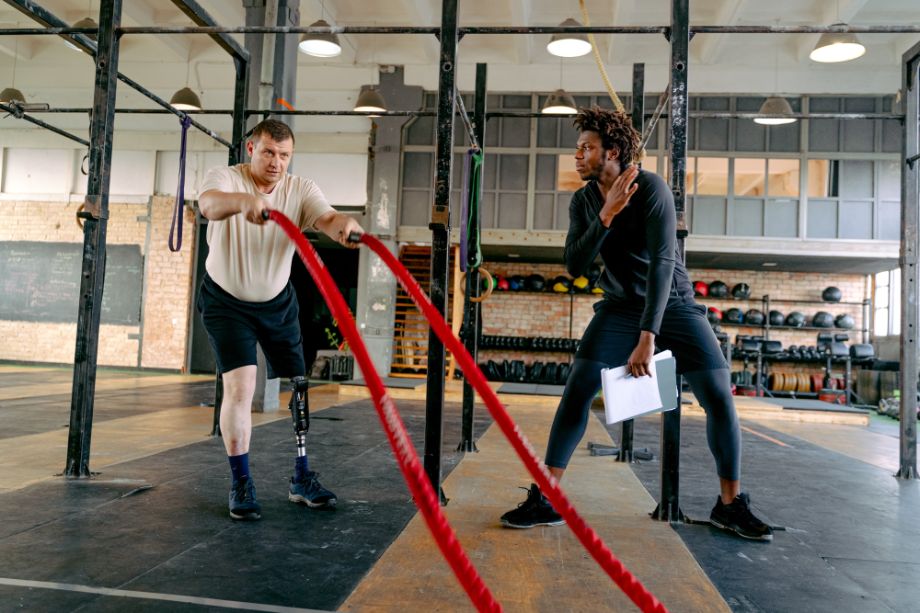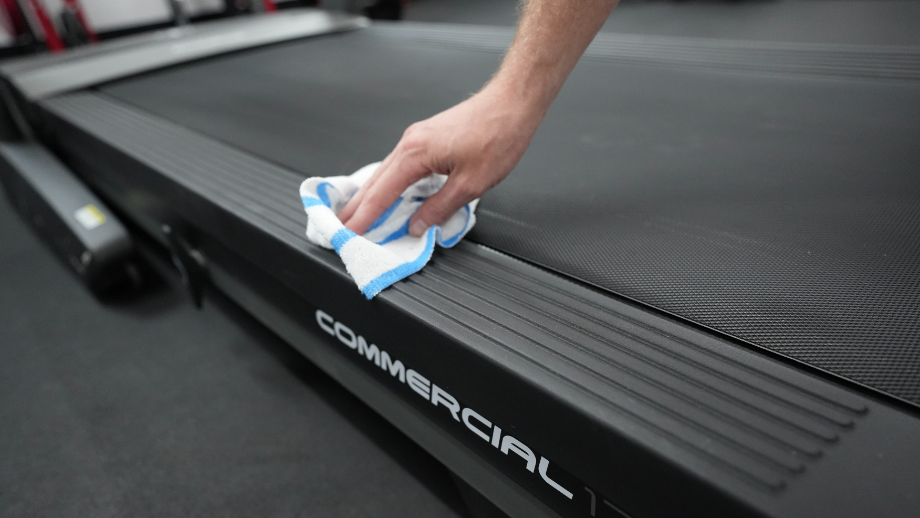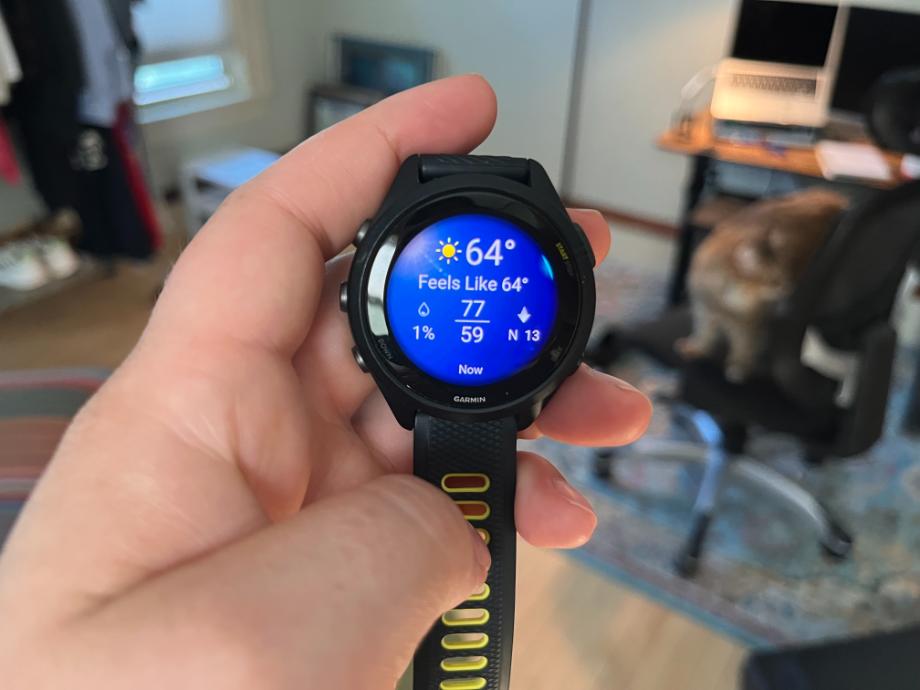Tackling this intense hero workout requires a calculated approach, self-awareness, and sheer mental toughness!
I’ll always remember my first Murph workout.
I was a brand new CrossFitter who finished with bloodied hands, lungs ablaze, and arms too tired to even wave goodbye to fellow exhausted athletes. I thought, “Okay, got that out of my system. Never again.”
And then I proceeded to do Murph every year for the next five years.
As a longtime CrossFitter and admitted glutton for pain, I have completed Murph just about any way you can do it: with a weight vest, with a partner, partitioned, and modified. I’m also a CrossFit L1 Trainer and former affiliate owner who has coached Murph and led hundreds of people through this brutal, but iconic workout.

So how should you tackle this challenge?
I’ll share my advice on how to train for Murph below. I also polled our Home Gym Community on Facebook for their take on Murph: the good, the bad, and the legendary.
Medical disclaimer: This article is intended for educational and informational purposes only. It is not a substitute for health or medical advice. For medical advice, contact an appropriate healthcare provider.
What Is the Murph Workout?
So, how does this story translate to a benchmark workout that involves running 2 miles and doing 600 repetitions of pull-ups, push-ups, and air squats?
Lt. Michael Murphy did many grueling workouts while wearing a military-issued weight vest. One of his favorites was called “Body Armor,” and it was a 1-mile run, followed by 100 pull-ups, 200 push-ups, 300 squats, and then a 1-mile run, all while wearing a weighted vest.
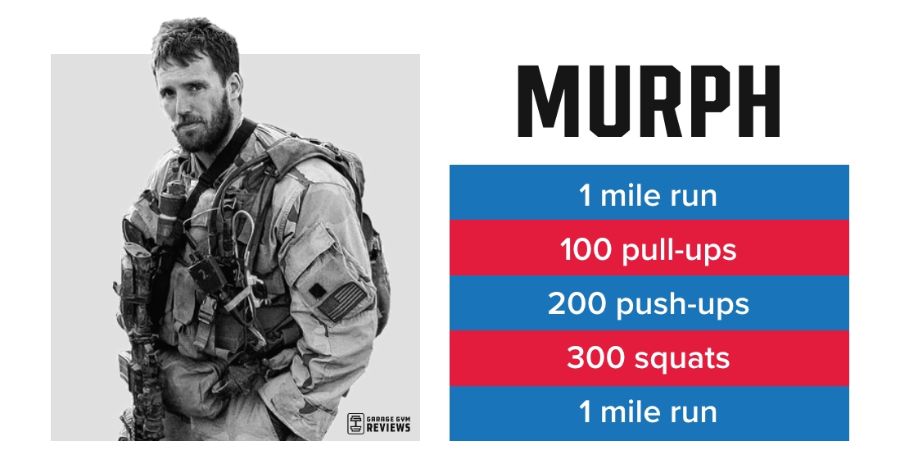
The workout was posted on CrossFit.com for the first time on Aug. 18, 2005, around two months after Lt. Murphy died. Only it wasn’t called “Body Armor” when it was posted; it was called “Murph” in honor of the fallen SEAL.
The CrossFit community has many workouts named after men and women killed in action. These are known as “Hero WODs,” and they often evoke feelings beyond the usual endorphin boost. Many people sense a deeper connection to a Hero WOD (WOD = workout of the day).

“It’s an extremely powerful experience: You can’t quit; you can’t give up; you can’t even whine because even though it’s hard, you know it’s nowhere near as hard as what Lt. Michael Murphy and his fellow SEALs endured,” says Amanda Capritto, a CrossFit Level 1 Trainer. “I truly have found myself on the verge of tears every time I’ve completed Murph, and not from the physical pain I was in.”
Murph Challenge Training Plan
The biggest mistake you can make in doing Murph is to underestimate the workout by overestimating your abilities. If you’ve never done 50 pull-ups in a workout, don’t expect to be able to do 100 in Murph.
In fact, it’s downright dangerous to attempt this challenge without first following a Murph workout training plan. Walking away with muscle soreness is the best-case scenario; too often, you see serious injuries and implications, like rhabdomyolysis, a serious medical condition that occurs when muscle tissue becomes damaged and releases proteins into the bloodstream.

How can you be prepared and avoid disaster? Here are our best Murph workout tips.
Step 1: Assess Your Strengths and Weaknesses
Take an honest look at your fitness level, then look at the workout, then look at your fitness level again.
You don’t have to do the workout as written. In fact, as a CrossFit Level 1 Trainer who has seen her share of Murph disasters, I can confidently say that the majority of people should NOT do Murph as written.
Elite athletes finish Murph as written, unpartitioned, in 30 to 40 minutes.
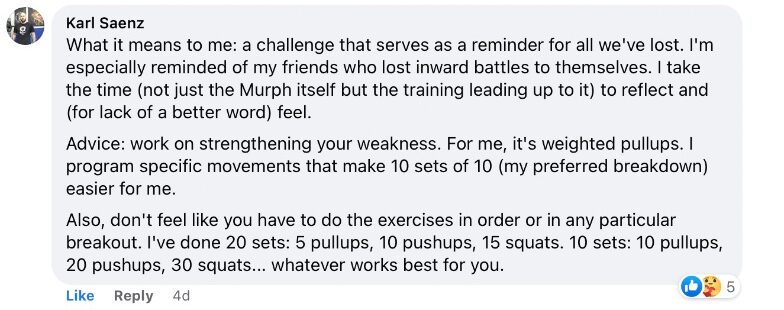
Most people should choose a version of “Murph” that they can complete in 45 minutes to an hour.
Why? Because most people aren’t used to exercising for much longer than that unless they are endurance athletes, and many endurance athletes are not used to doing high-volume push-ups and pull-ups.
I’m a big fan of doing things that are hard, but I’m not a big fan of watching people get hurt. If this workout takes you longer than an hour, it probably means you have to take a lot of breaks. If you are down to a point where you are doing one push-up every 30 seconds, you probably shouldn’t be trying to do 200 push-ups for the health of your body.
The beautiful (and most disheartening) thing about Murph is that it will find your weakness and expose it. Knowing where you can excel and where you need improvement will help you prep for the workout. Develop a plan to train your weaknesses. When it comes to your strengths, those are the parts of the workout you can take advantage of by pushing the pace or pushing the number of movements you can do at a time.
Step 2: Train Volume
In general, you should start preparing at least a month in advance with a goal of building muscular endurance in the movements. To accomplish this, keep your training specific to the movements and the pattern you do them in Murph. For example, train pull-ups, push-ups, and squats, and train them in the order they are done in the workout.
Performing high-repetition, low-weight (or in this case, bodyweight) training is key. If you are solely focused on Murph, training pull-ups, push-ups, and squats two or three days a week is ideal. If you do another type of training alongside Murph, doing even just one day of volume training is still good preparation.
When it comes to the run portion, you can of course walk if you’re tired. I’ll be the first to say that the last mile is a real burner, especially if you live in a hotter climate like I do.
Consider sandwiching your Murph workout days with run intervals, starting with 400 meters at least, and working your way up.
What does volume training look like? It depends on your current fitness level and what you’re trying to build up to. If you want to do Murph as written, you will need to build your fitness to a point where you can do 100 pull-ups, 200 push-ups, and 300 squats in one bout.

Some ideas for workouts to build volume over a month-plus of training include:
Workout One:
5 rounds:
5 pull-ups
10 push-ups
15 squats
*Add one round every week, or add a few reps on each exercise every week
Workout Two
12 EMOM (Every minute on the minute)
Minute 1: 20 seconds of pull-ups
Minute 2: 30 seconds of push-ups
Minute 3: 40 seconds of squats
*Track your reps, and each week, try to add another rep or two to each round
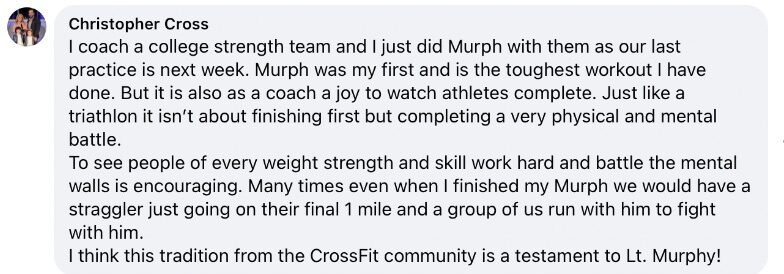
Step 3: Take Care of Your Hands
The sting. The shudder.
Ripped hands are just awful. They are also unnecessary and can derail your training and totally ruin Murph Day.
I could write an entire article on proper hand care, but here are the basics:
- Trim your calluses
- Wear gymnastics grips
- Use chalk
Do these things in your training leading up to Murph, and make sure your hands are ready for the big day.
Step 4: Stay Hydrated
Many people do Murph over Memorial Day weekend. It can get really hot, which means you can dehydrate quicker. Drinking water the day of the workout is not enough, and focusing on your hydration leading up to the event is one of the most important parts of your Murph preparation.
Recommendations for daily water intake are all over the place. Most people know the guideline of “eight glasses of water a day,” but the truth is, hydration needs vary based on your activity level, sex, climate, and more. Even the Centers for Disease Control and Prevention points out that there is no set daily intake for water.

Your best bet is to make sure you are drinking water every day leading up to Murph. Eight glasses is a great rule of thumb, but remember: Your body has a thirst mechanism, and it doesn’t lie. Pay attention to your body’s thirst signals and indicators of dehydration, such as urine that’s dark in color.
Also, hydration requires more than plain water, particularly when performing high volumes of physical activity. On the day of the challenge, bring a drink with electrolytes to have before, during, and after the workout.

Step 5: Modify Movements
The wonderful thing about Murph is that, just like any other workout, it is infinitely scalable.
I have coached countless people with injuries and limitations on Murph day. Every movement in Murph has a modification. Here are my go-to substitutions:
| Movement | Option 1 | Option 2 | Option 3 |
|---|---|---|---|
| Run (numbers based on a 1-mile run sub) | Row (2,000 m) | Air Bike (120 cal) | Bike (4,000 m) |
| Pull-up | Ring Row | Barbell Row | Banded Lat Pulldown |
| Push-up | Elevated Push-ups | Push-ups on knees | Floor press |
| Squat | Squat to a box/ball | Anchored squats | Sumo squats |
Modify the Workout
As written, Murph is a 1-mile run, followed by 100 pull-ups, 200 push-ups, 300 squats, and then a 1-mile run – all while wearing a weighted vest.
I don’t know that there are exact statistics on this, but I’m willing to bet that only the top 1 percent of any CrossFit box membership is able to do the workout as it’s written without a serious risk of injury.

The good news for everyone else is that there are many ways to do Murph.
“Logistically, I prefer to break Murph up into the ‘Cindy’ version,” says Amanda Capritto, an experienced CrossFitter who has done Murph several times. “This works better for me because my pushing and pulling stamina isn’t phenomenal.”
Different Options for Scaling Murph
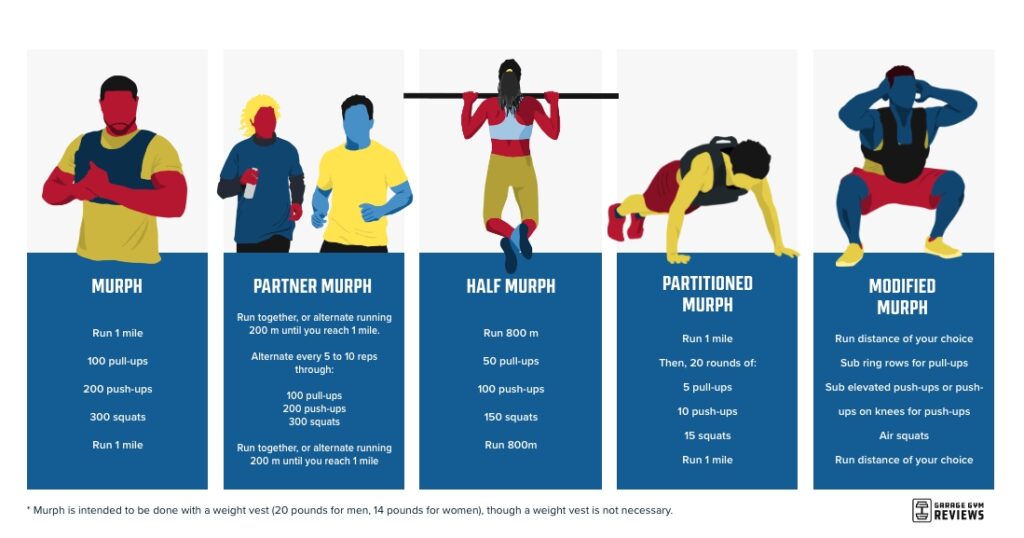
Or, you know, you can always be like these folks who must be absolute animals.
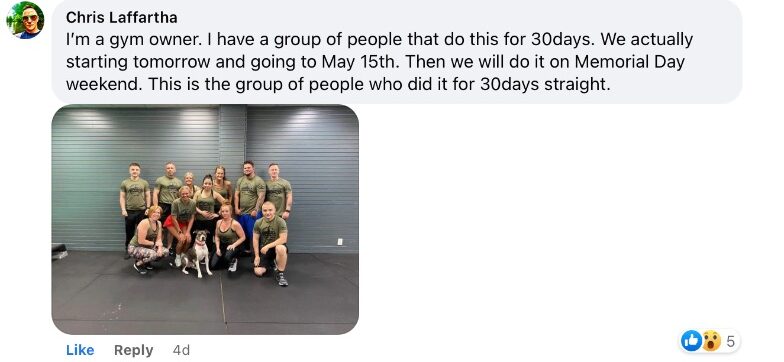
Who Was Lt. Michael Murphy?

To better understand the workout, you need to understand the man behind it.
Lt. Michael P. Murphy was a U.S. Navy SEAL. In June 2005, he was an officer-in-charge of a four-man team for Operation Red Wing, a reconnaissance mission in Afghanistan. Murphy, whom friends called “Murph,” and his team had been scouting the leader of a guerrilla group when they were spotted.
At the time, Murph and the other men, Danny Dietz, Marcus Luttrell, and Matthew Axelson, were on foot at around 10,000 feet above sea level in the mountains. Enemy forces opened fire on the SEAL squad, and a firefight ensued.
The team tried to reach safety by heading down the mountain, and in doing so, compromised their ability to contact headquarters for help.
Murph had suffered at least one gunshot wound when he decided to risk his life to move into open space and send a distress signal. Under fire, he was able to contact the Bagram Air Base and provide the team’s location.
Unfortunately, a rocket-propelled grenade struck the rescue helicopter, killing the 16 men on board. Murphy, Dietz, and Axelson lost their lives in the battle. Luttrell managed to escape to a nearby village and was eventually rescued a few weeks later on July 2.
The full story is captured in the movie “The Lone Survivor,” which I highly recommend watching–especially if you plan on doing the workout.
Murphy received the Purple Heart from former President George W. Bush, who cited his gallantry in risking his life for his men. He was also awarded the Medal of Honor, the highest military decoration someone can receive.

How Did the Murph Workout Begin?
In 2007, Dr. Joshua Appel gathered a group of people at his CrossFit gym on Memorial Day to do the “Murph” workout. Dr. Appel had served as an Air Force para-rescueman, and he led the team that recovered the bodies of Lts. Murphy and Dietz.
That group did the workout every year on Memorial Day, and in 2010, Dr. Appel contacted Lt. Murphy’s father to ask if he could launch a fundraiser incorporating the workout. Thus, the Murph Challenge was born.
According to The Murph Challenge website, more than $2 million has been raised for the LT. Michael P. Murphy Memorial Scholarship Foundation. Thousands of people have completed the workout and raised money through the site. However, countless more do Murph on Memorial Day every year, as it’s now a popular CrossFit workout. It’s also performed in other locations around the world.
When Does the Murph Challenge Take Place?
“Murph” is now done over Memorial Day weekend in CrossFit boxes, commercial gyms, garage gyms, and backyards around the world. “The Murph Challenge” is an annual fundraiser for the LT. Michael P. Murphy Memorial Scholarship Foundation.

FAQs About Murph
Should I wear a weight vest to do Murph?
Right off the bat, my answer is “probably not.” If you have to ask whether or not you should wear a weighted vest, my concern is that you haven’t trained in a weight vest enough to make sure you are safe doing 600 reps under fatigue and under a load.
“I don’t wear a vest because I am (what I consider) an intermediate CrossFitter, and the physical repercussions could be pretty severe,” Amanda Capritto says.
I have worn a vest to do Murph. It was during a time in my training when I was doing a lot of weighted pull-ups and push-ups, so I felt prepared. I only did it the one time, however, because I haven’t trained like that since.
If you do want to do Murph in a vest, train to do Murph in a vest. Spend at least a month leading up to the big day doing pull-ups, push-ups, squats, and running in a vest. Don’t just show up on Murph day with a vest and a grin and expect things to go well.
Should I do kipping or strict pull-ups in Murph?
This is such a hot topic. Right off the bat, there is a group of people who consider kipping pull-ups to be “not real” pull-ups. For those who don’t know, kipping pull-ups are a movement in which you use your lower body to “kip” and create momentum to help you get your chin above the bar.
I have a strict rule in my classes that unless you can do 5 to 10 strict pull-ups, you shouldn’t be doing kipping pull-ups. Period. Kipping can put a strain on your shoulders that, if you lack the strength, can lead to injury.
When it comes to Murph, die-hard competitors and those who train for it might tackle it with strict pull-ups. I have done partner Murph with strict pull-ups, and let me tell you, those 50 stricties HURT when all was said and done.
Whichever you choose, make sure you pick a movement you can do safely for as many reps as you plan on doing.
How long does it take to do Murph?
This depends on your fitness level and how you tackle the workout. Elite CrossFitters who do Murph finish the workout as written, unpartitioned, in 30 to 40 minutes.
This is a good baseline, but it isn’t what you should expect. Choosing a version of the workout that you can complete in 45 minutes to an hour is advisable. If you can’t run half a mile, attempting to do Murph and walking for 20 minutes in the first mile doesn’t set you up for a fun experience.
Is Murph a hard workout?
Murph is one of the most challenging workouts you can do because it involves a lot of volume (as in, a lot of reps) of movements that are challenging for the average person (pull-ups and push-ups).
This doesn’t mean that beginners can’t do Murph. In fact, I encourage it! However, work with a fitness professional to modify the movements and the volume to match where you are in your fitness.
What is the world’s fastest Murph?
On June 18, 2021, Alec Blenis completed Murph in full and unpartitioned in 32:41, beating Hunter McIntyre’s previous record of 34:13. Elite CrossFitters have done Murph several times at the CrossFit Games. Sometimes the workout was unpartitioned and other times it was partitioned.




